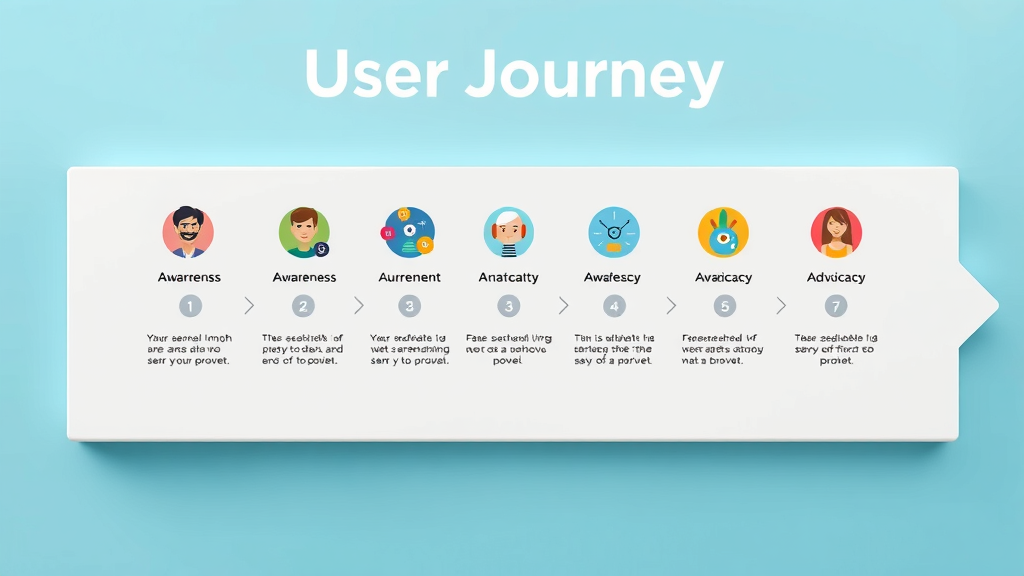Did you know? Nearly 20% of customers slip away because brands overlook key moments that really matter—moments that could have turned a frustrated user into a loyal advocate. Customer journey mapping is the secret weapon top-performing businesses use to plug these leaks, delight customers, and drive sustained growth. In this comprehensive guide, you’ll discover how mapping your customer journey transforms pain points into wins—and positions your team to deliver standout experiences at every step.

Did You Know? Most Businesses Lose 20% of Customers Due to Overlooked Touchpoints: The Power of Customer Journey Mapping
For many organizations, overlooked customer touchpoints quietly erode loyalty and profits—often before anyone realizes there’s a problem. These missed moments can be as subtle as a slow customer service response, an unclear website process, or an impersonal follow-up. The result? Customers feel disconnected and start exploring other options. Customer journey mapping helps businesses see these hidden gaps, identifying every touchpoint where customers interact—online and offline—across the entire customer journey.
By using journey maps , companies gain a bird’s-eye view of their user experience, shining a spotlight on pain points, friction, and opportunities for delight. Whether your customer base is global or local, mapping the journey provides actionable insights to reduce churn, streamline interactions, and build lasting relationships. Successful brands don’t leave the customer experience to chance—they methodically plot every customer touchpoint to ensure nothing gets missed, and that every experience is as seamless as possible.
Why Customer Journey Mapping Is the Missing Link for Success
Many companies focus on sales, features, and customer support, but they often neglect the glue that brings these elements together: the customer journey map . Customers rarely interact with a business in a single moment; instead, their journey is made up of distinct phases—awareness, consideration, decision, and retention—each carrying its own expectations and challenges. Without journey mapping, important details such as anxiety at checkout, confusion during onboarding, or frustration with customer service can be easily overlooked.
Effective journey mapping uncovers pain points, highlights moments of delight, and empowers businesses to proactively address customer needs. This doesn’t just improve metrics like retention; it creates genuine advocates who tell others about their positive experience. Ultimately, journey mapping is the bridge between product/service delivery and brand loyalty, transforming fragmented touchpoints into a unified, compelling customer experience.
What You'll Gain: How Customer Journey Mapping Empowers Your Organization
- A comprehensive understanding of customer journey mapping and best practices
- Practical ways to create impactful journey maps
- Insight into real customer pain points, experiences, and touchpoints
- A guide to applying journey mapping for customer retention and business growth
- Step-by-step breakdowns, examples, and templates

Understanding Customer Journey Mapping and Its Business Impact
What Is Customer Journey Mapping? Definitions and Key Principles
Customer journey mapping is the process of creating a visual representation —or journey map —that outlines every step your customer takes from discovering your brand to becoming a loyal advocate. This map is a powerful tool for understanding the customer’s experience, as it details their actions, thoughts, and emotions at each stage. The main objective is to put yourself in your customers' shoes and see your business through their eyes, not just from the company’s perspective.
The most effective customer journey maps capture real-world details: customer touchpoints , interactions (such as website visits, sales calls, customer service inquiries), emotional responses, and the underlying needs that drive behavior. By visualizing the entire customer journey, teams can better understand the customer, quickly identify pain points, and anticipate the needs of both current and potential clients. This approach helps bridge internal knowledge gaps, align teams, and deliver a seamless, compelling user experience.

The Business Case: Customer Journey Maps for Growth and Retention
Why should your organization invest in customer journey mapping ? Because businesses that truly understand their customers outperform those that don’t. When you visualize the journey—step by step—you spot opportunities to improve customer retention , nurture relationships, and differentiate your brand. For example, a journey map might reveal that your onboarding emails aren't engaging enough or that your customer support process creates frustration.
Acting on these insights can reduce drop-off rates, boost satisfaction, and directly increase revenue. Customer journey maps drive decision-making by highlighting which improvements will have the most substantial impact on both the customer experience and the bottom line. Increasingly, high-growth companies credit journey mapping as pivotal in scaling their business, optimizing service, and creating lasting value.
Difference Between Customer Journey Map, Service Blueprint, and Experience Maps
While they may sound similar, a customer journey map , service blueprint , and experience map serve unique purposes. A customer journey map focuses on the customer’s perspective, mapping every touchpoint they encounter. In contrast, a service blueprint adds another layer by linking customer actions with the back-end processes and systems that support those actions. An experience map is an even broader visualization, exploring a user’s experiences over time—even outside of direct interaction with your business.
The key distinction is that customer journey maps help you understand the entire customer experience , service blueprints optimize the operational layers behind those experiences, while experience maps look at the customer’s wider needs or journey across products and services—not just within your brand. Used together, these tools give a holistic understanding of how to elevate your customer’s journey.
"A customer journey map is the single most powerful tool for turning insight into action." – Industry Expert
Core Components of Customer Journey Maps: From Personas to Touchpoints
Defining Buyer Persona and Customer Persona: The Foundation
Every journey map starts with clarity on who your customer is; that’s where buyer personas and customer personas come in. A buyer persona is a semi-fictional representation of your ideal customer based on real data and educated guesses about demographics, needs, motivations, and behaviors. Customer personas can include details like industry, job title, goals, and pain points. Getting this foundation right ensures your journey mapping targets your real customer base —not just your assumptions.
These personas become the North Star for mapping decision-making: every touchpoint, message, and solution should map back to solving specific needs for your target audience. A well-crafted persona gives teams a living, breathing reference for uncovering friction, personalizing interactions, and delivering value at every stage.

Mapping Customer Touchpoints: Where Interactions Shape Experience
Customer touchpoints are the interactions where customers and companies meet, from initial brand awareness—like seeing an ad on social media—to requesting support after purchase. Every journey map must identify these touchpoints as moments that shape the user experience. Mapping each customer touchpoint across the current state journey delivers insight into what’s working and what’s not.
For instance, does your website navigation confuse visitors at the consideration stage? Is your checkout process causing drop-offs at decision? Are your email follow-ups keeping customers engaged at retention? Journey mapping makes these invisible factors visible, empowering companies to refine, prioritize, and optimize the customer experience at every phase.
Identifying Pain Points and Customer Needs on the Journey Map
Pinpointing pain points —the moments where customers face frustration or friction—is the heart of impactful journey mapping. Every journey map template should highlight where users hesitate, stall, or abandon the process. These pain points might stem from overwhelming information, slow response from customer service , unclear communication, or complex interfaces.
By collecting real customer feedback at each stage and analyzing quantitative and qualitative data, organizations can prioritize which issues need immediate attention. Addressing pain points based on actual needs (not guesswork) streamlines the user experience, reduces barriers, and turns obstacles into opportunities for delight and loyalty.
Step-by-Step Guide: Creating a Customer Journey Mapping Strategy
The 7 Steps to Map the Customer Journey
- Set clear objectives for your customer journey mapping
- Create detailed buyer personas and customer personas
- Map out each customer touchpoint
- Gather and analyze customer feedback at every stage
- Identify customer pain points and friction areas
- Visualize your customer journey map with templates and tools
- Continuously test, update, and refine your journey maps
| Stage | Touchpoints | Customer Emotions | Pain Points | Actionable Insights |
|---|---|---|---|---|
| Awareness | Ads, Social Media | Curiosity | Information Overload | Clarify Key Messaging |
| Consideration | Website, Reviews | Interest, Comparison | Lack of Trust | Strengthen Testimonials |
| Decision | Sales Calls, Checkout | Anxiety, Anticipation | Complicated Process | Simplify Process |
| Retention | Customer Service, Email | Loyalty, Reassurance | Slow Support | Enhance Response Time |
Journey Map Templates, Tools, and Best Practices for Customer Journey Mapping
Types of Customer Journey Map Templates: Choose the Right Model
Choosing the right journey map template depends on your goals and the complexity of your customer journey. There are several popular models:
- Current state journey map: Focuses on the present-day experience, highlighting strengths and weaknesses.
- Future state journey map: Envisions the ideal customer experience after improvements.
- Day-in-the-life map: Captures all activities (relevant and peripheral) a customer experiences in a typical day.
- Service blueprint: Integrates front-stage (customer-facing) touchpoints with underlying backend processes.

Top Digital Tools for Journey Mapping and Visualization
Today’s organizations have access to advanced digital tools that make creating a customer journey map intuitive, collaborative, and actionable. Platforms like Smaply, Miro, Lucidchart, and UXPressia enable teams to visualize complex customer journeys, annotate touchpoints , and update insights in real-time. Many tools offer template libraries with drag-and-drop elements for rapid prototyping.
The best digital tools support cross-functional input; marketing, sales, product, and customer service teams can all contribute their expertise, ensuring nothing falls through the cracks. Visualization features—such as emotion curves, journey stages, and pain point highlights—bring the journey map to life, bridging strategy with day-to-day implementation.

Real-World Examples: High-Impact Customer Journey Maps
Consider a SaaS company that used journey mapping to boost customer retention . By mapping every customer touchpoint from signup to monthly check-ins, they uncovered that onboarding emails lacked clarity, causing confusion at a critical moment. After revising communications and providing proactive support, churn rates dropped while customer loyalty soared.
Another example: a retail brand mapped the entire path from first ad view to post-purchase feedback. They found “friction” at the payment and delivery phases—uncertainty around shipping status left customers anxious. By introducing real-time tracking and transparent updates, the business dramatically improved satisfaction and repeat purchases.
Optimizing Customer Experience Through Ongoing Journey Mapping
How Journey Mapping Uncovers Hidden Pain Points and Experience Gaps
Businesses often overlook subtle moments that shape the user experience—until journey mapping reveals the truth. By laying out each customer touchpoint , you can spot gaps that analytics or surveys might miss, such as recurring confusion during checkout or a drop-off after onboarding. These “aha!” moments help companies prioritize solutions that truly move the needle.
Ongoing journey mapping not only exposes pain points; it tracks how improvements impact real customer journeys over time. Successful brands build a culture of continuous optimization, revisiting their journey map regularly to ensure they’re still meeting evolving customer needs—and staying ahead of the competition.

Integrating Customer Feedback and Continuous Improvement
The best journey maps are never one-and-done—they’re dynamic, evolving with fresh insights from direct customer feedback . Gathering feedback at every stage, from NPS surveys to live chat transcripts, gives a full-spectrum view of the user experience. Combining qualitative input with usage data provides a holistic understanding of what’s working and where improvement is needed.
Continuous improvement means making small, targeted changes in response to feedback—then measuring, refining, and scaling what works. This adaptive approach ensures your company never loses touch with real customer needs, making growth and retention sustainable over the long term.
Proactive Customer Service: Enhancing Every Customer Touchpoint
Customer service isn’t just a reactive function—it’s a core touchpoint that shapes the entire journey. Proactive service anticipates customer questions and removes potential friction before it escalates into a pain point. For example, well-timed communications, transparent self-serve resources, and attentive after-sales support reduce frustration and build trust.
When journey maps reveal opportunities to delight customers (such as personalized account check-ins or surprise rewards for loyal users), integrating these elements into customer service makes the experience memorable and encourages ongoing engagement.
The 5 Main Points of a Customer Journey: Stages and Milestones
- Awareness
- Consideration
- Decision
- Retention
- Advocacy

Applying These Stages to Your Customer Journey Map
Every customer journey map should structure the user’s experience around five main milestones: Awareness (first discovering your brand), Consideration (evaluating options), Decision (making a purchase), Retention (building loyalty), and Advocacy (recommending your business). Breaking the journey into these phases exposes the unique needs, pain points, and emotions at each step—helping teams optimize touchpoints where they matter most.
The key is to craft targeted communications, offers, and support strategies for each stage. For instance, the most effective strategies for retention rely on post-sale engagement and ongoing customer support, while driving advocacy requires exceeding expectations and empowering customers to share positive stories.
Overcoming Common Challenges in Customer Journey Mapping
Avoiding Data Silos: Integrating Insights Across Customer Touchpoints
One of the biggest hurdles in customer journey mapping is moving beyond departmental silos. Often, marketing, sales, support, and product teams each have pieces of the puzzle, but their data isn’t shared or integrated. This fragmented view results in an incomplete journey map that misses critical pain points or touchpoints.
To overcome data silos, organizations should centralize feedback, link metrics across systems, and encourage open knowledge sharing. Collaboration ensures your journey map is truly comprehensive and actionable—leading to unified experiences that are consistent and seamless for the entire customer base.
Conquering Internal Resistance to Journey Mapping Initiatives
Introducing customer journey mapping can sometimes meet internal pushback, especially from teams wary of extra work or change. Overcoming this resistance requires clear communication of the benefits—such as improved retention, simpler workflows, and happier customers—as well as demonstrating quick wins from early mapping efforts.
Involving cross-functional teams in the process and celebrating journey mapping successes transforms doubters into champions, making journey mapping a central part of your company culture.
Case Studies: Customer Journey Mapping in Leading Organizations
Success Story: Driving Customer Retention with Journey Maps
A major telecom provider struggled with high turnover in their subscription base. By building a detailed customer journey map, they identified a pain point during the setup phase—confusing instructions and limited onboarding support. By introducing clearer communication and proactive onboarding assistance, their customer retention rate increased by 18% in a single year.

Example: How Customer Service Transformed Through Journey Mapping
In the hospitality sector, a hotel chain used journey mapping to overhaul their customer service . Journey maps revealed hidden friction in the check-in/check-out process and found guests felt unsupported in resolving post-stay issues. Revamping these touchpoints with streamlined check-in and 24/7 support created lasting loyalty and a surge in five-star reviews.
These stories show the transformational power of journey mapping when teams use maps to truly understand the customer and deliver value at every step.
Best Practices and Pro Tips for Effective Journey Mapping
- Involve cross-functional teams in creating a customer journey map
- Leverage data and real customer feedback for accuracy
- Start small, iterate, and scale your mapping efforts
- Regularly review the customer journey for evolving needs
- Document customer pain points with actionable next steps
People Also Ask: Expert Answers on Journey Mapping
What are the 7 steps to map the customer journey?
The seven steps to mapping the customer journey are: defining clear objectives, building detailed buyer and customer personas, identifying every customer touchpoint, collecting customer feedback at all stages, isolating pain points and barriers, visualizing your journey map using the right template, and continuously updating your map to reflect new insights. These steps ensure a structured, comprehensive approach to customer journey mapping .
Detailed Answer: Step-by-Step Process for Customer Journey Mapping
Start by setting measurable goals—such as reducing churn or improving onboarding satisfaction. Develop in-depth personas that capture the diversity of your customer base . Map out each customer touchpoint and collect feedback through surveys or analytics. Identify pain points and opportunities, then visualize your findings using a digital tool or map template. Test, review, and refine your journey map regularly to maintain customer-centricity and foster continuous improvement.
What are the 5 main points of a customer journey?
The five main points are Awareness, Consideration, Decision, Retention, and Advocacy. Each stage represents a major milestone in the journey, from discovering your brand (Awareness) to loyal customers championing your business (Advocacy). Focusing strategies on each phase creates a more targeted and effective user experience.
Detailed Answer: Exploring Customer Journey Map Milestones
Milestones in a customer journey map include: Awareness (brand discovery through ads or social media), Consideration (comparing you with competitors), Decision (purchase or signup), Retention (sustained post-sale engagement), and Advocacy (referrals, ratings, and reviews). Each stage requires unique messaging and attention to touchpoints.
What are the 4 stages of customer journey mapping?
The four stages commonly referenced are: Mapping Customer Personas, Identifying Touchpoints, Highlighting Pain Points/Solutions, and Optimizing Experience. These stages guide teams through understanding, visualizing, improving, and tracking the entire customer journey.
Detailed Answer: Breaking Down the Four Key Phases
Begin with persona creation to ground the process in real user needs. Next, map out the end-to-end customer journey, capturing each touchpoint. Third, use feedback and analytics to surface pain points and propose solutions. Finally, iterate, monitor, and enhance the experience to ensure your journey mapping work leads to measurable business outcomes.
What are 5 basic steps in consumer journey?
The five basic steps for mapping the consumer journey are: Define your audience, Outline the stages of the journey, Identify key touchpoints, Gather data, and Visualize insights. This process ensures you systematically capture how your customers discover, evaluate, buy, and engage with your brand.
Detailed Answer: Basic Steps for Mapping the Consumer Journey
Start by specifying your audience using buyer or customer personas. Then break the journey into stages, such as awareness and retention. Identify every interaction point, whether digital or in-person. Collect both quantitative (analytics) and qualitative (surveys, interviews) data. Finally, build out your journey map template and share with stakeholders for validation and refinement.
Common Questions and Advanced FAQs on Customer Journey Mapping
- How often should you update a customer journey map?
- What’s the difference between customer journey mapping and service blueprints?
- Can journey mapping help improve digital customer experience?
- How to gather unbiased customer feedback for journey mapping?
- Which roles should be involved in creating a journey map?
Advanced Customer Journey Mapping: Beyond Basics
Combining Journey Maps with Service Blueprints for Holistic Customer Experience
Advanced teams layer their journey map on top of a service blueprint to align customer-facing steps with supporting processes and technology. This combination uncovers deeper root causes of pain points and ensures that improvements meet both customer needs and operational realities. For example, if a pain point is slow support response, the blueprint can highlight workflow or staffing bottlenecks.
By merging both tools, businesses create not just better experiences for customers—but more efficient, cost-effective, and scalable internal operations as well.
Leveraging AI and Big Data in Customer Journey Mapping
Artificial intelligence (AI) and big data are revolutionizing customer journey mapping by automating data analysis, predicting customer behavior, and identifying subtle trends across millions of interactions. AI tools can analyze chat logs, purchase patterns, and support tickets to surface hidden pain points or opportunities for personalized engagement.
Big data enhances accuracy by pulling in signals from web analytics, CRM, social listening, and more. This data-driven approach helps teams refine their journey map in real time, offering recommendations for optimizing content, support, and customer touchpoints at scale.

Summary: Key Takeaways for Getting Started With Customer Journey Mapping
- Customer journey mapping reveals actionable growth insights
- Best results come from cross-team collaboration and continuous updates
- Address pain points, map touchpoints, and use real data for accuracy
- Regularly measure impact and adapt journey maps for ongoing success
Your Next Step: Maximize Growth with Expert Customer Journey Mapping
"Ready to grow your business? Book your free Marketing Strategy Session at https://imodagency1.com or call 5626207576 to unlock your successful customer journey mapping strategy today."
Take action: Map your customer journey, listen to your customers, and transform every touchpoint into a chance for growth. The future of your brand starts with customer journey mapping done right.
To deepen your understanding of customer journey mapping, consider exploring the following resources:
-
“Customer Journey Map: Everything You Need To Know” by Forbes Advisor provides a comprehensive overview of customer journey maps, detailing their components and benefits. ( forbes.com )
-
“What is a Customer Journey Map & Why Is it Important?” by IMD offers insights into the significance of customer journey maps and outlines a step-by-step process for creating them. ( imd.org )
These articles offer valuable perspectives and practical guidance to enhance your customer journey mapping initiatives.
 Add Row
Add Row  Add
Add 




Write A Comment